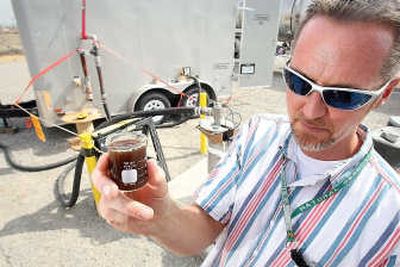Hanford hopes cleanup will stick

RICHLAND – Hanford scientists hope that pumping enough molasses to make 88,000 batches of cookies into the ground at the nuclear reservation will be a recipe for cleanup success.
The theory is that adding a rich food supply for microbes should change the groundwater chemistry enough to convert some of the toxic chromium moving toward the Columbia River into a nontoxic form.
“It’s very cool that you can have high technology using a very common, inexpensive material,” John Price, manager for environmental restoration for the state Department of Ecology, said Thursday as a solution of molasses and water was pumped into the ground.
When Hanford’s reactors were producing plutonium for the nation’s nuclear weapons program, enough sodium dichromate was used to prevent corrosion in reactor cooling water that it was brought to the reactors in tanker rail cars.
Spills and the dumping of contaminated reactor water have left the ground at three reactor areas along the Columbia River polluted with enough chromium that it’s reaching the river.
The largest chromium plume is near the D and DR reactors, where one monitoring well has found toxic chromium at 10,580 parts per billion. The drinking water standard is 100 parts per billion, but because the chemical is harmful to fish, including spawning salmon, the limit for chromium in river gravel beds is 10 parts per billion.
The Department of Energy, working with contractor Fluor Hanford, has had some success capturing chromium near the D and DR reactors or changing it into a less toxic form. But there’s so much chromium in the soil that it continues to move into the groundwater as fast as it is removed.
“We’re trying to find other solutions that are more innovative, more cost-effective,” said Mike Thompson, DOE groundwater cleanup manager.
A tanker truck of molasses, 5,500 gallons, is being mixed into a solution that’s 95 percent water. This week, it’s being injected into the groundwater that lies in a 20-foot layer about 85 feet below the ground near the D Reactor. It’s expected to spread out to cover a diameter of about 100 feet.
“Basically, we’re adding sugar water,” said Mike Truex, a Pacific Northwest National Laboratory scientist. That will overfeed the bacteria in the groundwater, causing the population to explode.
The growing bacteria population will provide an electron-rich environment to manipulate the valence of chromium as it hits the area. It should convert from toxic chromium 6 to nontoxic chromium 3, the same type of chromium that comes in a daily multivitamin.
The molasses injection also is planned to bolster a chemical barrier – the in-situ reactive barrier – installed earlier along the Columbia River. It relies on natural iron in the aquifer formation that turns to rust as water contaminated with chromium 6 passes through it. As the iron oxidizes, it gives up electrons that turn the chromium 6 to chromium 3.
But one of the best parts of the molasses experiment may be its cost. The truckload of molasses, more commonly used for cattle feed, cost $5,000.
“This is one of the least expensive materials we could come up with,” Price said.
The molasses injection should last for about a year, with microbes first feeding on the sugar, then on decaying bacteria as it begins to die off. Researchers expect to see results in three to six months.
Next year, the second phase of the experiment is planned. Then vegetable oil will be injected into the ground, emulsified in water just as oil is emulsified in salad oil.
Scientists want to compare the two forms of carbohydrates and watch how they spread in the groundwater and how long they last to see which is most efficient.